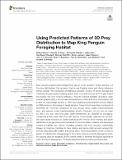Files in this item
Using predicted patterns of 3D prey distribution to map king penguin foraging habitat
Item metadata
| dc.contributor.author | Proud, Roland | |
| dc.contributor.author | Le Guen, Camille Melanie Marie-Anne | |
| dc.contributor.author | Sherley, Richard | |
| dc.contributor.author | Kato, Akiko | |
| dc.contributor.author | Coudert, Yan-Ropert | |
| dc.contributor.author | Ratcliffe, Norman | |
| dc.contributor.author | Jarman, Simon | |
| dc.contributor.author | Wyness, Adam | |
| dc.contributor.author | Arnould, John P. | |
| dc.contributor.author | Saunders, Ryan A. | |
| dc.contributor.author | Fernandes, Paul G. | |
| dc.contributor.author | Boehme, Lars | |
| dc.contributor.author | Brierley, Andrew Stuart | |
| dc.date.accessioned | 2021-11-29T10:30:04Z | |
| dc.date.available | 2021-11-29T10:30:04Z | |
| dc.date.issued | 2021-11-29 | |
| dc.identifier | 276371609 | |
| dc.identifier | 5f5525c9-6f1b-489a-b48b-eb0491f72294 | |
| dc.identifier | 85121268094 | |
| dc.identifier.citation | Proud , R , Le Guen , C M M-A , Sherley , R , Kato , A , Coudert , Y-R , Ratcliffe , N , Jarman , S , Wyness , A , Arnould , J P , Saunders , R A , Fernandes , P G , Boehme , L & Brierley , A S 2021 , ' Using predicted patterns of 3D prey distribution to map king penguin foraging habitat ' , Frontiers in Marine Science , vol. 8 , 745200 . https://doi.org/10.3389/fmars.2021.745200 | en |
| dc.identifier.issn | 2296-7745 | |
| dc.identifier.other | ORCID: /0000-0002-6438-6892/work/104252274 | |
| dc.identifier.other | ORCID: /0000-0002-8647-5562/work/104252460 | |
| dc.identifier.uri | https://hdl.handle.net/10023/24416 | |
| dc.description | Funding: The at-sea data collection and 50% of CLG’s PhD studentship was provided by the Swiss Polar Institute as a grant ‘Unlocking the Secrets of the False Bottom’ to ASB. The School of Biology, University of St Andrews, funded the other 50% of CLG’s studentship. Work at South Georgia was supported by Natural Environment Research Council’s Collaborative Antarctic Science Scheme (CASS-129), a grant from the Trans-Antarctic Association Grant to RBS, and a British Antarctic Survey Collaborative Gearing Scheme grant to RBS and ASB. | en |
| dc.description.abstract | King penguins (Aptenodytes patagonicus) are an iconic Southern Ocean species, but the prey distributions that underpin their at-sea foraging tracks and diving behaviour remain unclear. We conducted simultaneous acoustic surveys off South Georgia and tracking of king penguins breeding ashore there in Austral summer 2017 to gain insight into habitat use and foraging behaviour. Acoustic surveys revealed ubiquitous deep scattering layers (DSLs; acoustically detected layers of fish and other micronekton that inhabit the mesopelagic zone) at c. 500 m and shallower ephemeral fish schools. Based on DNA extracted from penguin faecal samples, these schools were likely comprised of lanternfish (an important component of king penguin diets), icefish (Channichthyidae spp.) and painted noties (Lepidonotothen larseni). Penguins did not dive as deep as DSLs, but their prey-encounter depth-distributions, as revealed by biologging, overlapped at fine scale (10s of m) with depths of acoustically detected fish schools. We used neural networks to predict local scale (10 km) fish echo intensity and depth distribution at penguin dive locations based on environmental correlates, and developed models of habitat use. Habitat modelling revealed that king penguins preferentially foraged at locations predicted to have shallow and dense (high acoustic energy) fish schools associated with shallow and dense DSLs. These associations could be used to predict the distribution of king penguins from other colonies at South Georgia for which no tracking data are available, and to identify areas of potential ecological significance within the South Georgia and the South Sandwich Islands marine protected area. | |
| dc.format.extent | 18 | |
| dc.format.extent | 3858723 | |
| dc.language.iso | eng | |
| dc.relation.ispartof | Frontiers in Marine Science | en |
| dc.subject | Acoustic surveys | en |
| dc.subject | Aptenodytes patagonicus | en |
| dc.subject | Diving behaviour | en |
| dc.subject | Foraging habitat | en |
| dc.subject | King penguin | en |
| dc.subject | Prey distribution | en |
| dc.subject | Southern Ocean | en |
| dc.subject | South Georgia | en |
| dc.subject | QA Mathematics | en |
| dc.subject | QH301 Biology | en |
| dc.subject | DAS | en |
| dc.subject | SDG 14 - Life Below Water | en |
| dc.subject.lcc | QA | en |
| dc.subject.lcc | QH301 | en |
| dc.title | Using predicted patterns of 3D prey distribution to map king penguin foraging habitat | en |
| dc.type | Journal article | en |
| dc.contributor.sponsor | NERC | en |
| dc.contributor.institution | University of St Andrews. Scottish Oceans Institute | en |
| dc.contributor.institution | University of St Andrews. Pelagic Ecology Research Group | en |
| dc.contributor.institution | University of St Andrews. School of Biology | en |
| dc.contributor.institution | University of St Andrews. Marine Alliance for Science & Technology Scotland | en |
| dc.contributor.institution | University of St Andrews. Centre for Research into Ecological & Environmental Modelling | en |
| dc.contributor.institution | University of St Andrews. Sea Mammal Research Unit | en |
| dc.identifier.doi | https://doi.org/10.3389/fmars.2021.745200 | |
| dc.description.status | Peer reviewed | en |
| dc.identifier.grantnumber | NE/R012679/1 | en |
This item appears in the following Collection(s)
Items in the St Andrews Research Repository are protected by copyright, with all rights reserved, unless otherwise indicated.

